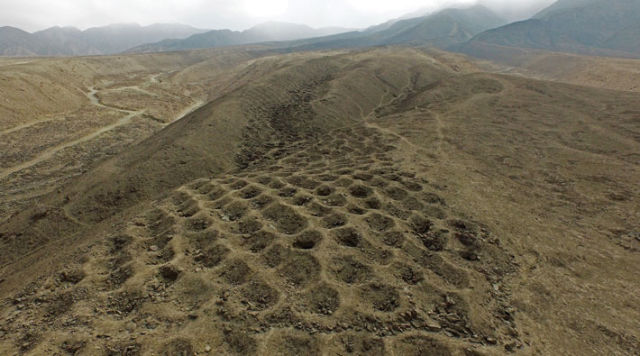The Band of Holes in Peru

Band of Holes
The Band of Holes in Peru, also known as Monte Sierpe or Cerro Viruela, is a mysterious series of human-sized holes found in the Nazca Plateau. The original purpose of these holes is unknown, and local people have no idea why they were dug.
Overview
In the early 1930s, a photograph by Robert Shippee in the National Geographic magazine brought the Band of Holes to the world’s attention. While their true purpose is unknown, it has been speculated that the holes were graves, storage pits, or even war defensive positions. Regardless of their origin, they remain a fascinating and mysterious place.
The Band of Holes is a series of human-sized holes located on a plateau in Peru. They are found in the Pisco Valley of the Nazca Plateau. It is thought that the formation of the band of holes dates back to the fifteenth century. The Inca Empire ruled the area in the fifteenth century and over the Chincha people. They were built above the agriculturally productive Pisco Valley.
The Band of Holes is a mysterious archaeological site in Pisco Valley, Southern Peru. Archaeologists at the University of California have studied the site, which is believed to be an ancient defensive structure. They also believe that the formation was a trail marker or a geoglyph in the tradition of the Nazca lines.
How long is the band of holes?
The band of holes is a mysterious site in Pisco Valley, Peru, which stretches over a mile. This site’s creators must have worked hours of work to build this massive creation. But what is its purpose? The mystery is still unclear and it is believed to have been a sacred site.
This unusual site could be an ancient burial site, a trail marker, or an ancient geoglyph in the tradition of the Nazca lines. Researchers don’t know for sure, but there are a few theories. One is that the holes may be human-sized. Others suggest that extraterrestrials may have created them. If so, ancient aliens may have visited the Earth and left some marks.
The Band of Holes was first brought to the world’s attention by a 1931 aerial photograph published in the National Geographic magazine. They are best appreciated when viewed from above. They remain a mystery, and theories about their purpose are many. Some speculate that they were built as vertical graves or geoglyphs, and others believe they were constructed as storage vessels.
What are holes in Machu Picchu?
The Incas dug holes three to four feet wide, which may have been used for measuring tribute paid to the Inca state. Today, researchers are trying to find ancient pollen and plant tissue in the soil surrounding the holes, and finding these will help explain why the holes are there and make them more interesting.
According to archaeologists, the holes may have served as storage sites or a tax and tribute system. They were built near an Incan highway and between two important Inca complexes. The Incans were highly skilled in engineering and building. They developed an elaborate tax and tribute system, but they needed help to quantify the value of their products.
The ancient city of Machu Picchu is watered by natural springs. To keep the city watered, the Incas devised an elaborate collection system. This system, which is still in use today, includes a 749-meter-long canal that transports water from the first spring to the city centre. The canal has stone-lined walls.
The stonework at Machu Picchu is unique in that it was constructed without wheels, iron tools, or mortar. The structures were constructed by hand using a rock-fitting method known as ashlar masonry, which helped the site remain standing despite the constant threat of earthquakes.
What are holes in Machu Picchu?
The holes are a mystery to historians, but one theory relates to ancient plant tissue and pollen. These materials may have been used as measurements in the tribute to the Inca state. The band of holes stretches for a mile and a half from the valley floor. Archaeologists believe they were dug by Incas, who were adept Masons and engineers.
In addition to their use as drainage channels, these holes serve another purpose. They are used to place sacred objects and mummies. These structures are part of a series of paras and tambos, ancient Inca stone walls. These areas were used for various religious functions and celebrations.
While most stone blocks in the complex were finished on site, some larger stones still have small indentations for ropes and workers. This may indicate that bricks and adobe were not used. Instead, most houses likely had a light finish made of ground stones and sand, and some walls were painted afterwards.
The site also has a quarry on site. The stones at Machu Picchu weighed over fifty tons and were carved out of the rock. The Incas probably used lamas to haul the stones to the site. They also used ropes and levers to pull the bigger stones. They did not have a wheel, so they used manual labour.
What was holes biggest song?
“Live Through This” is a life-changing album for Hole, and the band has never produced anything as ferocious and powerful as this. The frontwoman’s character also changes in Life Through This, and she becomes a ferocious if fragile, character (in “Violet”) and a ticking bomb (in “Doll Parts”).
The band’s second album was a lived tumult record featuring a foreboding prom queen on the cover. The album followed the emotional arc of their first album. It’s hard to say which song is Hole’s biggest hit, but there’s no doubt that the band’s music is unforgettable.
The band broke up in 2002 after the release of their album Celebrity Skin. Erlandson and Love claimed that it was a breach of their mutual contract. It was later revealed that the band reformed in 2010. Love reportedly claimed that the band’s disbandment resulted from a breach of contract.
The album’s title track, “Celebrity Skin,” is Hole’s most popular song. The album’s video features Courtney Love as a pale blonde with a cluster of beautiful women hanging around her. The music on Celebrity Skin balances punk rock and pop.
Why is the band Hole called Hole?
The band Hole was a ’90s alternative rock sensation. Its music was noisy and edgy, but its singer, Courtney Love, has since softened its sound and added more melodies to its songs. Hole’s name has evoked confusion. Some think the name comes from a line in Euripides’ Medea, but the lyrics don’t appear in any standard translation of the play.
The band was formed in 1989 in Los Angeles, California. The punk music of the ’80s influenced them, but their sound was incredibly unique. Eric Erlandson’s style of guitar playing, tight rhythms, and Amy Love’s powerful vocals defined their sound. The band’s debut album, Pretty on the Inside, was produced by Kim Gordon of Sonic Youth and quickly received widespread critical praise.
The band broke up in 1992 but later reformed with new members. Their third album, “Celebrity Skin”, sold around 2 million copies worldwide and garnered critical acclaim. In the same year, Cobain died from a self-inflicted shotgun wound.
Conclusion
The band of holes is an archaeological phenomenon that was first discovered by aviator Robert Shippee, who published the first photo of the band of holes in National Geographic magazine. A decade later, another aviator, Victor Wolfgang von Hagen, surveyed the area and wrote a book about the band of holes. Hagen described the band of holes as a stone-lined, circular cemetery with over 5,000 graves.




